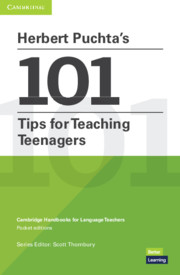 Herbert Puchta's 101 Tips for Teaching Teenagers
Herbert Puchta's 101 Tips for Teaching Teenagers Book contents
E - Speaking
Published online by Cambridge University Press: 28 October 2023
Summary
With 17 tips, this section is the longest in the book – justifiably so, I believe, in response to the point made by many colleagues that it is often so very difficult to get teens to talk in the target language. There are sound psychological reasons explaining why the most talkative teen can all of a sudden turn into a monosyllabic stony-faced automaton. Changing that for the better requires the use of a range of strategies aimed to show our learners both that we take them seriously – their emotions, fears (of making mistakes), their opinions, their interests and their own language – and that we can lead them, with the help of the right support and inspiring activities, into a safe and engaged use of the new language.
43 Use substitution tables
44 Engage your learners in small talk
45 Use anecdotes
46 Ask the right questions
47 Deal with silence successfully
48 Do use drills
49 Engage learners in effective roleplay
50 Have five-minute activities ready
51 Encourage learners to speak personally
52 Motivate your learners to stick to English in class
53 Design engaging problem-solving tasks
54 Show me your stickers and I’ll tell you …
55 Use concentric circles to foster fluency
56 Use consensograms as a basis for discussions
57 Engage learners in gallery walk conversations
58 Encourage discussions about values
59 The role of the learners’ own language (L1)
43 Use substitution tables
Substitution tables can be really helpful, especially for beginners.
Substitution tables support learners in creating linguistically correct sentences and also help them express themselves meaningfully. However, substitution tables need to go beyond mechanical drills. Paul Nation (2013) says, ‘Teachers need to make sure they not only provide opportunities for exact repetition, but that they also provide opportunities for repetition involving generative use. Retrieval involving generative use is one of the most powerful language learning conditions.’
Here is a substitution table for young teens beginning to learn English.
• Write the table on the board to familiarise learners with a key sentence pattern.
• Read out the top sentence in the table, pointing at it word for word. Get learners to repeat the sentence pattern in chorus and individually, then repeat with new sentences.
• Tell learners that you are going to point at an individual word/ phrase in a column that offers more than one option.
- Type
- Chapter
- Information
- Herbert Puchta's 101 Tips for Teaching TeenagersCambridge Handbooks for Language Teachers Pocket editions, pp. 47 - 64Publisher: Cambridge University PressPrint publication year: 2020
